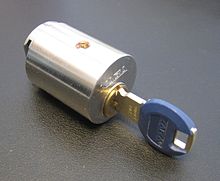Round cylinder
The round cylinders are a type of lock cylinder built into the 1960s , which together with a lock , door plate and bolt secure an area or a door. They are part of a locking system and can be recognized by their circular profile. "Swiss" round cylinders are the standard in Switzerland .
On the other hand, profile cylinders can be recognized by their elongated shape; they are the common type of security door locks used today in Germany.
Designs
Round cylinders are available as single and double cylinders, they consist of one or two parts and the diameter is 30 mm.
Double cylinders have an inner and an outer part that are attached to one another. For installation, the separate cylinder halves must be inserted into the lock from both sides until a mechanism locks the two halves in place. It is possible to put together two cylinder halves with different pin codes or locks.
A suitable key is required to remove the double cylinder. This is turned until a small opening appears on the key's keyway. The locking mechanism can then be unlocked using a pen tool that is inserted into the cylinder under the key and the cylinder halves are separated. Because of this division, double cylinders offer less security than the one-piece profile cylinders customary today, so they are rarely used.
Spare parts are still available, so it is not necessary to replace the lock and door fittings when replacing the cylinder. Even if replacement round cylinders are more expensive than profile cylinders, replacing them is worthwhile, as the costs for a new lock and fittings are saved.
Difference to profile cylinders
Manufacturers offer round and Euro profile cylinders that can be opened with the same key. Round cylinders are usually installed in such a way that the key bit points upwards, with profile cylinders it usually points downwards.
Double cylinders do not have a locking nose that moves the bolt in the lock when the key is turned, but the tip of the key itself, which protrudes into the space between the two cylinder halves, takes on this function. This feature must be taken into account when purchasing a cylinder.
In contrast to profile cylinders, double cylinders are not locked with a screw but with a built-in snap mechanism. Since this locking of the two cylinder pieces only takes place via one or two small noses of about 4 mm, these cylinders are more susceptible to forcible removal than the profile cylinders.
The installation of round and profile cylinders is identical. In the case of the fittings, only the round hole (22.4 or 30.4 mm) can be seen in the door plate of the round cylinder , while the door lock itself has cut out a web for it, with the profile cylinder the cutouts in the door lock and door plate are identical. Due to the larger diameter, it can be assumed that the "Swiss" cylinders allow a larger number of rows of tumblers .
"Swiss" round cylinder
The "Swiss" round cylinder is one-piece and has a diameter of 22 mm. The distance from the door handle, i.e. the center of the handle follower to the center of the round cylinder - according to the specifications of the Association of Swiss Lock and Fittings Manufacturers (VSSB 20200 series 3) - is 2 mm greater than the usual dimension in Germany up to the center of the profile cylinder core, z. B. 74 instead of 72 mm according to DIN EN 12209.
In some cases the driver of the cylinder has to be shortened by about 1 mm in order to be usable in a door lock made in Germany. The fitting plates or rosettes should only be installed when the cylinder is locked in place with the fastening screw.
